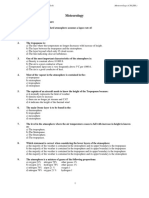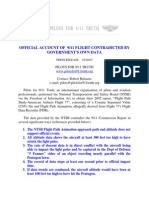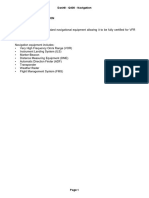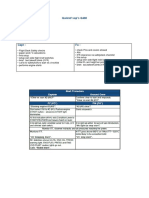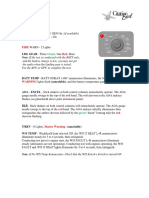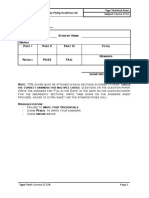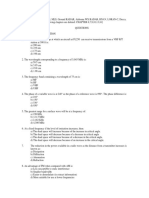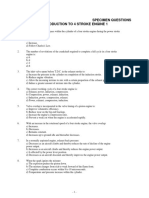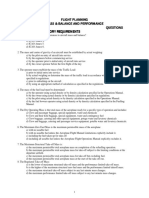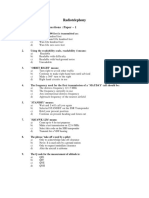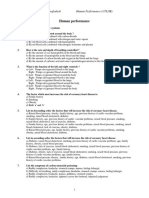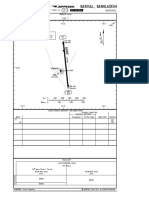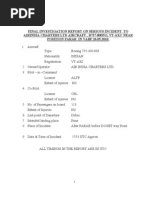Q400 Communications
Q400 Communications
Uploaded by
MoshiurRahmanCopyright:
Available Formats
Q400 Communications
Q400 Communications
Uploaded by
MoshiurRahmanOriginal Description:
Copyright
Available Formats
Share this document
Did you find this document useful?
Is this content inappropriate?
Copyright:
Available Formats
Q400 Communications
Q400 Communications
Uploaded by
MoshiurRahmanCopyright:
Available Formats
Dash8 - Q400 - Communications
12.4
12.4.1
(ATA 23) COMMUNICATIONS
Introduction
The Audio and Radio Management System (ARMS) is used to control and monitor the communication systems that follow:
Radio Communication (RCOM) and Radio Navigation Management
Passenger Address and Communication Interphone System (PACIS)
Audio Integration System (AIS)
The Dash 8-Q400 aeroplane also has the following communication related equipment:
Cockpit Voice Recorder (CVR)
Flight Data Recorder (FDR)
Emergency Locator Transmitter (ELT)
12.4.2
General
The ARMS uses two Audio and Radio Control Display Units (ARCDU 1, ARCDU 2) to supply the
flight crew and observer with individual control of the:
Communication radios
Navigation receivers audio signals
Interphone between pilot, copilot, observer, and ground crew
Passenger Address and Communication Interphone System (PACIS)
Pilot and copilot stations have:
ARCDU
Phone Jack Panel
Hand microphone
Flight deck speaker
Control wheel Push-To-Talk (PTT) Interphone switch
There is also a PTT switch on the nosewheel steering control, and an interphone transmit switch
on the copilot side panel.
The observers station has:
Phone Jack Panel
Audio Control Panel (ACP)
Transmit-interphone (INT/RAD) toggle switch
Page 1
Dash8 - Q400 - Communications
p
12.4.3
Controls and Indications - Communication
Page 2
Dash8 - Q400 - Communications
5 4
1
4
TEAM
3
6
V
H
F
1
124 . 470
V
O
R
1
112 . 15
A
D
F
1
236
ADF
I
N
T
DIM/BRT
CH2
121 . 900
MKR HI
109 . 100
CH1
341
V
H
F
2
125 . 400
I
L
S
2
109 . 100
A
D
F
2
236
ADF
A
T
C
1
4365
ONALT
118 . 350
DME
116 . 550 H
391
3520
ID
ON
OFF
BOTH
FMS
PG
1/2
EXP
DME
HOLD
CH
DIM
RTN
PREV
NEXT
MAINT
PA
CHIME
CALL
EMER
HF
AUX1
TUNE
7
VHF2
VHF1
VOR
MLS
SERV/INT
AUX2
DME
ADF
PA
NORM
SPKR
BOOM
MKR
EMER
OFF
MASK
HOT
MIC
Figure 12.4-1 Audio and Radio Control Display Unit (ARCDU) (1 of 6)
Page 3
Dash8 - Q400 - Communications
p
ARCDU CALLOUTS PERTAINING TO COMMUNICATIONS ITEMS
1. ACTIVE MATRIX LIQUID CRYSTAL DISPLAY Area
(colored font on black background)
-
typical first main page shown
2. ACTIVE FREQUENCY (green)
-
this is the current frequency in use
when the particular communication system sends valid data to the ARCDU, the digits are
displayed in green
invalid data or no data displays the digits in white
3. PRESET FREQUENCY (cyan)
-
when highlighted (cyan digits change color to black digits on cyan background), this area
is known as the tune window, or scratch pad
invalid data or no data displays FAIL in red text
4. LABEL (white)
-
identifies the applicable communication receiver unit
5. CHANNEL MEMORY ANNUNCIATION (green)
-
indicates active frequency is a stored channel
6. DIM/BRT ANNUNCIATION
(reverse video, black text on white background)
-
appears when the DIM/RTN key is selected
if no further action occurs within the next 5 seconds, the DIM/BRT annunciation is
removed
7. DIM/RTN KEY (momentary action)
PUSH - allows control of the brightness of the ARCDU screen
- DIM/BRT annunciation appears adjacent to the INT label
- turning either TUNE knob will adjust the brightness of the ARCDU screen while the DIM/
BRT annunciation is displayed
- turning the TUNE knob clockwise increases the brightness, and turning it counterclockwise decreases the brightness
- continued turning after min or max brightness is attained has no further action
- the RTN function is only active in maintenance mode
Page 4
Dash8 - Q400 - Communications
8
TEAM
125 . 500
V
H
F
3
127 . 750
V V
H H
F F
1 2
V
O
R
1
V D D
O M M
R E E
2 1 2
I
N
T
10
A A M
D D K
F F R
1 2
A
T
C
1
S
P
K
R
4365
11
ON ALT
3520
ID
ON
OFF
BOTH
FMS
EXP
DME
HOLD
CH
DIM
RTN
PREV
NEXT
MAINT
PA
CHIME
CALL
EMER
HF
AUX1
VHF2
VHF1
PG
1/2
VOR
MLS
TUNE
SERV/INT
AUX2
DME
ADF
PA
NORM
SPKR
BOOM
MKR
EMER
OFF
MASK
HOT
MIC
Figure 12.4-2 Audio and Radio Control Display Unit (ARCDU) (2 of 6)
Page 5
Dash8 - Q400 - Communications
p
ARCDU CALLOUTS PERTAINING TO COMMUNICATIONS ITEMS (contd)
8. ACTIVE MATRIX LIQUID CRYSTAL DISPLAY AREA
(colored font on black background)
-
typical second main page shown
second main page is displayed when the PG 1/2 key is pushed
9. SIDE KEYS (8, momentary action)
PUSH - allows two types of operations:
- changing of the preset frequency
- swapping of preset and active frequencies
- the above operations are done in conjunction with the TUNE knob
- if there is no action with the TUNE knob within 5 seconds of a side key being pushed, the
selection is cancelled
- pushing on another side key within 5 seconds of the first push, will cancel the previous
tune window and activate a tune window associated with this side key
- pushing a side key adjacent to a blank area, or adjacent to INT, will have no effect
- when an action on a side key is not allowed, the label associated with this key flashes for
5 seconds
- details on how to tune windows is described on the following pages
10. PG 1/2 KEY (momentary action)
PUSH - allows the display of:
- the second main page when the first main page is displayed
- the first main page when the second main page or any particular page is displayed
- when there is no second main page, this key has no effect when the first main page is
displayed
11. EXP KEY (momentary action)
PUSH - an action on this key done after an action on a side key, like radio communication
(VHF1, VHF2, etc.), radio navigation (VOR1, VOR2, etc.), or others, allows the display of the
particular pages dedicated to the selected system
- scratchpad selection remains active for a further 5 seconds as soon as the particular
page is displayed
- if the EXP key is selected with no previous side key selection, nothing happens
Page 6
Dash8 - Q400 - Communications
12
TEAM
V SBY CTL
H
CH2
F
1
V
H
F
2
125 . 400
Tx
V
O
R
1
112 . 15
I
L
S
2
109 . 100
A
D
F
1
236
A
D
F
2
236
MKR HI
109 . 100
ADF
CH1
341
I
N
T
118 . 350
15
DME
116 . 550 H
A
T
C
1
ADF
391
4365
ONALT
3520
ID
ON
OFF
13
14
BOTH
FMS
EXP
DME
HOLD
CH
DIM
RTN
PREV
NEXT
MAINT
PA
CHIME
CALL
EMER
HF
AUX1
VHF2
VHF1
PG
1/2
VOR
MLS
TUNE
16
17
SERV/INT
AUX2
DME
ADF
PA
NORM
SPKR
BOOM
MKR
EMER
OFF
MASK
HOT
MIC
Figure 12.4-3 Audio and Radio Control Display Unit (ARCDU) (3 of 6)
Page 7
Dash8 - Q400 - Communications
p
ARCDU CALLOUTS PERTAINING TO COMMUNICATIONS ITEMS (contd)
12. SBY CTL ANNUNCIATION (green)
-
displayed when the standby control and display for VHF1 COM (COM control display) is
turned on
if the COM control display is activated while in any of VHF1 particular pages, the display
returns to the first main page
if the COM control display is activated, access to VHF1 particular page is inhibited; an
action on EXP key done after an action on VHF1 side key will induce the flashing of the
VHF1 label for 5 seconds
13. ROTARY SWITCH (4 position)
OFF - the ARCDU is not powered. The related FMS controls and tunes as a backup
ON - the ARCDU controls and tunes its related radio system
BOTH - the ARCDU controls and tunes its related and opposite radio systems (Cross Side
Tuning)
FMS - the FMS controls and tunes its related and opposite radio systems (cross side tuning)
14. PREV KEY (momentary action)
PUSH - allows the return to the previous page displayed
- if one of the main pages is displayed, the display remains the same
-
maintenance function only
15. COMM TX ANNUNCIATION (green)
-
displayed for the duration when a push to talk is activated for a radio communication by
any crew member
16. CH KEY (momentary action)
PUSH - key toggles the tuning mode of the selected radio between frequency tuning mode
and channel tuning mode
- key is active only when one of the following radios is selected: VHF1, 2, 3 or VHF NAV1,
2 or ADF1, 2
- the TUNE knob allows the selection of one of the channels which have previously been
programmed
17. NEXT KEY (momentary action)
PUSH - allows the next page to be displayed
- if one of the main pages is displayed, the display remains the same
-
maintenance function only
Page 8
Dash8 - Q400 - Communications
TEAM
18
V
H
F
1
124 . 470
V
O
R
1
112 . 15
A
D
F
1
236
I
N
T
DIM/BRT
CH2
121 . 900
MKR HI
109 . 100
ADF
CH1
341
V
H
F
2
125 . 400
I
L
S
2
109 . 100
A
D
F
2
236
118 . 350
DME
116 . 550 H
A
T
C
1
ADF
391
4365
ONALT
3520
ID
ON
OFF
20
BOTH
FMS
EXP
DME
HOLD
CH
DIM
RTN
PREV
NEXT
MAINT
PA
CHIME
CALL
EMER
HF
AUX1
VHF2
VHF1
PG
1/2
VOR
MLS
TUNE
19
SERV/INT
AUX2
DME
ADF
PA
NORM
SPKR
BOOM
MKR
EMER
OFF
MASK
HOT
MIC
Figure 12.4-4 Audio and Radio Control Display Unit (ARCDU) (4 of 6)
Page 9
Dash8 - Q400 - Communications
p
ARCDU CALLOUTS PERTAINING TO COMMUNICATIONS ITEMS (contd)
18. VOLUME LEVEL ADJUST BAR GRAPH (white or green)
WHITE - the respective audio pushbutton is selected off
GREEN - the respective audio pushbutton is selected on
- the height of the bar graph shows the volume selection level
19. TUNE KNOBS (2, rotary action)
TURN - changes digits of selected parameter
- the outer knob selects the digits left of the decimal
- the inner knob selects the digits right of the decimal
- both knobs have roll over capability
- variable rate tuning advances the frequency several digits when the inner knob is rotated
rapidly
- if the CH key has been pressed, the TUNE knobs will cycle through the programmed
channels for the selected radio
20. COMM PUSHBUTTON SWITCHES (5)
(alternate action switch and rotary volume control)
PUSH - turns respective comm receiver audio ON/OFF
ROTATE - changes comm audio volume level
- the display area shows the volume level as a vertical bar graph
- the height of the bar graph is representative of the volume level
- the pushbuttons AUX1 and AUX2 are used to control optional radios which do not have
their own pushbuttons; for instance, AUX1 for VHF3 and AUX2 for HF2
- when a basic or optional radio system is not installed, the associated pushbutton has no
effect. It remains OFF and audio level is zero
- pushbuttons labeled HF, SPKR and MKR have volume level bar graphs on the second
main page
- the listening level of the Audio Warnings is not adjustable and cannot be turned ON/OFF
- ON/OFF positions and pushbuttons settings are saved on power cut and restored at
power up
- ON/OFF selections can be overridden by the Emer/Norm switch or automatic reconfiguration (see Detailed Description). The same is true for pushbuttons settings
Page 10
Dash8 - Q400 - Communications
TEAM
21
V
H
F
1
124 . 470
V
O
R
1
112 . 15
A
D
F
1
236
I
N
T
PA Tx
CH2
121 . 900
MKR HI
109 . 100
ADF
CH1
341
V
H
F
2
125 . 400
I
L
S
2
109 . 100
A
D
F
2
236
118 . 350
DME
116 . 550 H
A
T
C
1
ADF
391
4365
ONALT
3520
ID
22
ON
OFF
BOTH
FMS
PG
1/2
EXP
DME
HOLD
CH
DIM
RTN
PREV
NEXT
MAINT
PA
CHIME
CALL
EMER
HF
AUX1
VHF2
VHF1
TUNE
SERV/INT
AUX2
24
23
1
VOR
MLS
DME
ADF
PA
NORM
SPKR
BOOM
MKR
EMER
OFF
MASK
HOT
MIC
25
Figure 12.4-5 Audio and Radio Control Display Unit (ARCDU) (5 of 6)
Page 11
Dash8 - Q400 - Communications
p
ARCDU CALLOUTS PERTAINING TO COMMUNICATIONS ITEMS (contd)
21. INT TX ANNUNCIATION (green)
-
when the activated push to talk is related to the INT or PA system, the annunciator
becomes INT Tx or PA Tx respectively, and is displayed for the duration of the push to
talk
when HOT MIC is on, Tx will display full time
22. SPKR ON ANNUNCIATION (green)
-
indicates speaker pushbutton switch is selected on
23. SERV/INT PUSHBUTTON SWITCH
(alternate action switch and rotary volume control)
PUSH - turns the SERV/INT receiver audio ON/OFF
ROTATE - changes SERV/INT audio volume level
- the INT display area shows the volume level as a vertical bar graph
- the height of the bar graph is representative of the volume level
24. MICROPHONE/ INTERPHONE SELECTOR (rotary action, 7 position)
TURN - selects communications radios (VHF1, VHF2, HF, AUX 1 or 2) or interphone communication between crew members (SERV/INT) or Public Address Cabin Interphone
System (PA) for transmission
- when a push to talk is activated for a radio communication by any crew member, a green
Tx annunciation is displayed for the duration of the push to talk on the radio communication area
- the SERV/INT position allows any push to talk switch to be used for interphone communication. Interphone conversations between the flight crew member and the attendant
can be monitored only when the INT volume control push button is in the ON position
- selection for transmission can be overridden by the Emer/Norm switch or automatic
reconfiguration (see Detailed Description)
25. SPEAKER PUSHBUTTON SWITCH
(alternate action switch and rotary volume control)
PUSH - turns overhead speaker ON/OFF
ROTATE - changes speaker volume level; displayed on second main page.
Page 12
Dash8 - Q400 - Communications
TEAM
V
H
F
1
124 . 470
V
O
R
1
112 . 15
A
D
F
1
236
I
N
T
V
H
F
2
125 . 400
I
L
S
2
109 . 100
236
341
A
D
F
2
EMER
A
T
C
1
CH2
121 . 900
MKR HI
109 . 100
ADF
CH1
118 . 350
DME
116 . 550 H
ADF
391
4365
ONALT
3520
ID
ON
OFF
BOTH
FMS
EXP
DME
HOLD
CH
DIM
RTN
PREV
NEXT
MAINT
PA
CHIME
CALL
EMER
HF
AUX1
VHF2
VHF1
PG
1/2
VOR
MLS
TUNE
26
SERV/INT
AUX2
DME
PA
28
NORM
SPKR
BOOM
MKR
EMER
OFF
MASK
ADF
HOT
MIC
27
Figure 12.4-6 Audio and Radio Control Display Unit (ARCDU) (6 of 6)
Page 13
Dash8 - Q400 - Communications
p
ARCDU CALLOUTS PERTAINING TO COMMUNICATIONS ITEMS (contd)
26. EMER/NORM SWITCH (two position)
NORM - provides normal operation of the Audio and Radio Management System (ARMS)
- all radios are individually selectable with variable volume control
EMER - selects emergency mode
- EMER will be displayed in red on the third line of the INT area
-
when selected on pilots ARCDU:
the headset and microphones are directly routed to VHF1
the interphone audio side-tone is directly routed to the headset
audio level is fixed for VHF1 and INT
when selected on copilots ARCDU:
the headset and microphones are directly routed to VHF2
the interphone audio side-tone is directly routed to the headset
audio level is fixed for VHF2 and INT
the PTT/INPH must be selected to PTT for access to onside COMM. Interphone function
is not available in EMER except for Audio
the microphone/interphone selector is overridden while EMER mode is selected
EMER mode has precedence over automatic reconfiguration
in automatic reconfiguration mode, FAIL is annunciated instead of EMER, however, it
appears on the second line of the INT area
27. HOT MIC SELECTOR (two position switch)
ON - microphones are automatically and continuously keyed for interphone operation only
HOT MIC - normal position, microphones must be keyed for operation
- in automatic reconfiguration, interphone system is in hot microphone mode, so HOT MIC
position has no effect
28. BOOM/ MASK MICROPHONE (two position switch)
BOOM - transmit from boom microphone
MASK - transmit from oxygen mask microphone
Page 14
Dash8 - Q400 - Communications
TEAM
V
H
F
1
V
O
R
1
A
D
F
1
124 . 470
CH2
121 . 900
112 . 150
MKR HI
109 . 100
236
CH1
ANT
341
I
N
T
V
H
F
2
125 . 400
I
L
S
2
109 . 100
A
D
F
2
A
T
C
1
118 . 350
CH4
116 . 550
236
BFO
391
4365
ON ALT
3520
ID
ON
OFF
BOTH
FMS
EXP
DME
HOLD
CH
DIM
RTN
PREV
NEXT
MAINT
PA
CHIME
CALL
EMER
HF
AUX1
VHF2
VHF1
PG
1/2
VOR
MLS
TUNE
AUX2
SERV/INT
DME
ADF
PA
NORM
SPKR
BOOM
MKR
EMER
OFF
MASK
HOT
MIC
Figure 12.4-7 ARCDU VHF Communication Operation (1 of 3)
Page 15
Dash8 - Q400 - Communications
p
ARCDU VHF COMM FREQUENCY SELECTION
SWITCHING BETWEEN ACTIVE AND PRESET FREQUENCIES
Push the side key adjacent to the VHF label to highlight (black digits on cyan background)
the preset code
If no further action occurs within the next 5 seconds, the preset frequency reverts back to
cyan digits
Push the side key again and the preset frequency becomes the active frequency, and the
active frequency becomes the preset frequency
CHANGING THE PRESET FREQUENCY
Push the side key adjacent to the VHF label to highlight the preset code
Turn the TUNE knobs to change the preset code to the desired frequency
Push the side key again and the preset frequency becomes the active frequency
SELECTING A MEMORIZED PRESET FREQUENCY
Push the CH key to activate the channel mode selection function
The channel memory annunciator CH x (where x is the programmed channel from 1 to 8) is
displayed on the second line of the display area and its associated frequency is displayed as
the preset frequency
Push the side key adjacent to the VHF label to highlight and change the preset frequency
The channel number changes to reflect the preset frequencies memory location (8 possible
per label)
If the TUNE knob is not operated within the next 5 seconds, the preset frequency reverts
back to cyan digits
Turn either TUNE knob to display the memorized channels one after the other:
- from the displayed channel number if a channel number is already displayed (preset frequency associated)
- from CH 1 if no channel number is already displayed (preset frequency not associated)
Push the side key again and the preset frequency becomes the active frequency
The channel memory number appears in green below the active frequency. This shows that
the active frequency is associated with a channel memory number
When the CH key is pushed again, the channel memory mode changes to the normal frequency selection. All channel memory annunciators are removed
Page 16
Dash8 - Q400 - Communications
TEAM
V
H
F
1
124.470
121.900
TEST
CHANNELS
I
N
T
A
T
C
1
6600
ON ALT
3520
ID
ON
OFF
BOTH
FMS
EXP
DME
HOLD
CH
DIM
RTN
PREV
NEXT
MAINT
PA
CHIME
CALL
EMER
HF
AUX1
VHF2
VHF1
PG
1/2
VOR
MLS
TUNE
AUX2
SERV/INT
DME
ADF
PA
NORM
SPKR
BOOM
MKR
EMER
OFF
MASK
HOT
MIC
Figure 12.4-8 ARCDU VHF Communication Operation (2 of 3)
Page 17
Dash8 - Q400 - Communications
p
ARCDU VHF COMM FREQUENCY SELECTION (contd)
VHF TESTING
Push the VHF side key followed by the EXP key to display the VHF particular page as
shown
The VHF label is displayed in black digits on a white background
The TEST legend is displayed in white text
Push the side key adjacent to the TEST legend to start the test of the VHF system
When TEST is selected, it changes to reverse video, and displays as black characters on a
green background
The audio module automatic squelch circuit is disabled to let the VHF communication
receiver noise be heard. This makes sure that the receiver is operational.
This is indicated by a green SQL message with a diagonal line through it on the second line
of the VHF area
Test duration is 1 second
The legend returns to white after the test sequence is completed
There is no test result indicated
Page 18
Dash8 - Q400 - Communications
TEAM
VHF1
VHF3
VHF2
VOR1/ILS1
ADF1
VOR2/ILS2
ADF2
CH1 124.500
CH5124.000
CH2 126.500
CH6 128.500
CH3 124.500
CH7 118.200
CH4 118.500
I
N
T
CH8 125.500
CALL HF1
A
T
C
1
6600
ON ALT
3520
ID
ON
OFF
BOTH
FMS
EXP
DME
HOLD
CH
DIM
RTN
PREV
NEXT
MAINT
PA
CHIME
CALL
EMER
HF
AUX1
VHF2
VHF1
PG
1/2
VOR
MLS
TUNE
AUX2
SERV/INT
DME
ADF
PA
NORM
SPKR
BOOM
MKR
EMER
OFF
MASK
HOT
MIC
Figure 12.4-9 ARCDU VHF Communication Operation (3 of 3)
Page 19
Dash8 - Q400 - Communications
p
ARCDU VHF COMM FREQUENCY SELECTION (contd)
CHANNEL PROGRAMMING
Push the VHF side key followed by the EXP key to display the VHF particular page
The VHF label is displayed in black digits on a white background
Push the side key adjacent to the CHANNELS legend to access the Channel Programming
page
The channel programming page contains a list of radios with channel capabilities (pilots on
the left, copilots on the right). One radio is selected and the frequencies for that radio are displayed
When channel programming is selected, the radio is selected which is associated on the particular page where the CHANNEL request originate
Eight preset channels are available for VHF communication tuning as displayed on the channel programming page
Channel presets are labeled as CH1 through CH8 in white characters. Each channel display
area contains two channel definitions. Successive pressing onside key shall successively
select one of the two channels
Push the side key to select the channel to be changed and the current frequency value
changes to black characters on a cyan background
Turn the two TUNE knobs located at the lower right side of the ARCDU to change the frequency
The channel window shows the new frequency in cyan characters
Page 20
Dash8 - Q400 - Communications
TEAM
V
H
F
1
124 . 470
CH2
121 . 900
V
O
R
1
112 . 15
A
D
F
1
236
I
N
T
PA Tx
MKR HI
109 . 100
ADF
CH1
341
V
H
F
2
125 . 400
I
L
S
2
109 . 100
A
D
F
2
236
A
T
C
1
4365
ONALT
118 . 350
DME
116 . 550 H
ADF
391
3520
ID
ON
OFF
BOTH
FMS
EXP
DME
HOLD
CH
DIM
RTN
PREV
NEXT
MAINT
PA
CHIME
CALL
EMER
HF
AUX1
VHF2
VHF1
PG
1/2
VOR
MLS
TUNE
AUX2
SERV/INT
DME
ADF
PA
NORM
SPKR
BOOM
MKR
EMER
Figure 12.4-10 ARCDU PACIS (1 of 2)
Page 21
OFF
MASK
HOT
MIC
Dash8 - Q400 - Communications
ARCDU CALLOUTS PERTAINING TO PACIS
1. PA KEY (MOMENTARY ACTION)
PUSH - key segment (green)
- selecting the microphone/interphone selector to PA, enables the flight crew to make PA
transmissions using the PTT/INPH switch
- green annunciator light on both ARCDUs, the PA lights on both the cabin attendant keyboard (FWD) and handset (AFT), and on the cabin attendant advisory light panels will
come on
- there is no volume control in PA mode
- the PA mode is terminated by pushing on the PA key again, by choosing another PACIS
mode (CALL or EMER) or by moving the microphone/interphone selector to another
transmitting position. The side tone is then set to zero
- when the PA mode is activated by another crew member, the PA key segment (green)
comes on as an indication, regardless of the microphone/interphone selector position
(there will be no side tone unless the selector is on the PA position)
- to activate the PA mode, the microphone/interphone selector shall be set on the PA position and then the PA key must be pressed
2. CALL KEY (MOMENTARY ACTION)
PUSH - key segment (green)
- with the microphone/interphone selector set to PA, it enables the pilot (or the copilot) to
call and communicate with the flight attendant(s)
- generate a chime sound in the cabin only
- green annunciator light on both ARCDUs, the CALL lights on both the cabin attendant
keyboard (FWD) and handset (AFT), and on the flight attendant advisory light panels will
come on
- the pilot (or the copilot) will be able to listen and talk to the attendant(s) on the intercom
network as soon as the attendant lifts the handset
- a PTT, INPH or HOT MIC selection is required by the flight crew in order to connect their
microphone to the interphone system
- when the CALL mode is activated by another crew member, the CALL annunciator is lit
up as an indication
- when a cabin attendant is calling the flight crew, a chime sound is generated in the flight
deck
- it is not necessary to press a PTT or the cabin crew handset when communicating on the
interphone
- this mode is terminated by pressing the CALL key again, by choosing another mode (PA
or EMER) or moving the microphone/interphone selector to another transmitting position
NOTE:
During emergency conditions in which the only aeroplane power is from the batteries
and the Emergency Lights switch is in the ARM or ON position, the PA and CALL
lights on the pilots ARCDU and both attendant keypads will be illuminated incorrectly
and should be ignored. This condition is a function of the operation of the RCAU and
in no way inhibits the correct audio function of the PACIS system.
Pilots PA operation continues to be indicated by a PA TX indication on the ARCDU
when the PTT is pressed and headset sidetone. Pilots CALL operation continues to
be indicated by a high-low chime heard on the cabin speakers and in the pilots headset.
Page 22
Dash8 - Q400 - Communications
TEAM
V
H
F
1
124 . 470
V
O
R
1
112 . 15
A
D
F
1
236
ADF
I
N
T
PA Tx
CH2
121 . 900
MKR HI
109 . 100
CH1
341
V
H
F
2
125 . 400
I
L
S
2
109 . 100
A
D
F
2
236
ADF
A
T
C
1
4365
ONALT
118 . 350
DME
116 . 550 H
391
3520
ID
ON
OFF
BOTH
FMS
EXP
DME
HOLD
CH
DIM
RTN
PREV
NEXT
MAINT
PA
CHIME
CALL
EMER
HF
AUX1
VHF2
VHF1
PG
1/2
VOR
MLS
TUNE
SERV/INT
AUX2
DME
PA
NORM
SPKR
BOOM
MKR
EMER
OFF
Figure 12.4-11 ARCDU PACIS (2 of 2)
Page 23
MASK
HOT
MIC
ADF
Dash8 - Q400 - Communications
p
ARCDU CALLOUTS PERTAINING TO PACIS (contd)
3. CHIME KEY (MOMENTARY ACTION)
PUSH - causes a chime sound to broadcast in the cabin
- this key operates regardless of the microphone/interphone selector position and of the
other PACIS mode
4. EMER KEY (MOMENTARY ACTION)
PUSH - key segment (amber)
- selecting the microphone/interphone selector to PA, enables the pilot (or the copilot) to
call and communicate with the flight attendant(s)
- same functionality as the CALL key, except:
- the amber EMER lights on the ARCDUs, and both the cabin attendant keyboard (FWD)
and handset (AFT), will flash
- there will be a red flashing annunciator on the cabin attendant advisory light panels
- the chime sound is broadcast on the flight deck and in the cabin
- the microphone/interphone selector must be selected to PA for the flight crew to hear the
cabin crew member
- the selection of the EMER mode at any other station overrides and postpones the CALL
mode (even if it is already activated)
- this mode is terminated by pressing on the same key again, by choosing another mode
(PA or CALL) or moving the microphone/interphone selector to another transmitting position
- when an emergency mode or an automatic reconfiguration occurs, the PA, CALL, and
EMER lights extinguish and PACIS modes are suspended
- on the same ARCDU, only one of the CALL, PA, and EMER modes can be activated at
any one time, but the activated mode on one ARCDU can be different from the activated
mode on the other one, therefore, two keys can be illuminated at the same time
Page 24
Dash8 - Q400 - Communications
p
COM 1
TX
135.975
121.500
ACT
OFF
ON
TEST
Figure 12.4-12 VHF1 Standby Control and Display Unit (1 of 2)
Page 25
Dash8 - Q400 - Communications
p
VHF1 STANDBY CONTROL AND DISPLAY UNIT CALLOUTS
1. OFF-ON-OFF TEST (three position, rotary switch)
OFF:Standby control panel OFF
ON: Standby control panel ON
TEST:- receiver squelch of the radio is disabled
-if background noise can be heard, the radio is operational
2. FREQUENCY AND ADVISORY DISPLAY
-
displays active frequency in upper portion
displays preset frequency in lower portion
the transmit annunciator displays Tx each time the microphone is keyed and a RF output
is present
3. ACTIVE FREQUENCY
-
shows that the top set of numerals is the active (ACT) frequency setting
the active frequency display is the top set of numerals to which the remote transceiver is
tuned
4. PRESET FREQUENCY
-
shows that the lower set of numerals is the preset (PRE) frequency setting
Page 26
Dash8 - Q400 - Communications
p
COM 1
TX
135.975
121.500
ACT
OFF
ON
TEST
Figure 12.4-13 VHF1 Standby Control and Display Unit (2 of 2)
Page 27
Dash8 - Q400 - Communications
p
VHF1 STANDBY CONTROL AND DISPLAY UNIT CALLOUTS (contd)
5. FREQUENCY SELECTOR (concentric, rotary action)
TURN - selects the desired frequency
- the outer (large) knob tunes the whole megahertz frequencies in increments of one MHz
- the inner (small) knob tunes the frequencies in increments of 25 KHz (or 8.33 KHz)
- clockwise rotation of either knob increases frequency and counter-clockwise rotation
decreases frequency
6. FREQUENCY TRANSFER PUSHBUTTON (momentary action)
PUSH (less than 2 seconds) - interchanges the active and standby frequencies on the display
PUSH and HOLD (2 to 3 seconds) - causes the standby frequency display to disappear
allowing the operator to change the active frequency setting
PUSH and HOLD (2 to 3 seconds for the 2nd time) - restores the standby frequency
display
PUSH and HOLD (more than 7 seconds) - causes the transceiver to retune to 121.500 MHz,
and display it in the top window. If nothing is displayed due to a display failure, any frequency can be selected knowing that every click on the large frequency selector knob
will give 1 MHz increment and the small knob will give 25 KHz (or 8.33 KHz) increment
7. TRANSFER ANNUNCIATOR
- displayed as long as the readback frequency (from the transceiver) is not the same as
the activate frequency, which follows the momentary push of the transfer switch
8. TRANSMIT ANNUNCIATION
- microphone has been keyed
- RF output present
Page 28
Dash8 - Q400 - Communications
p
NOTE
Pilot's equipment shown.
Copilot's equipment similar.
MIC
1
BOOM
MASK
PHONES
NORMAL
AUX
Figure 12.4-14 Pilots and Copilots Phone Jack Panel
Page 29
Dash8 - Q400 - Communications
PILOTS AND CO-PILOTS PHONE JACK PANEL CALLOUTS
1. MICROPHONE JACKS
BOOM - the headsets have a microphone plug that is connected to the BOOM jack to supply
boom microphone audio to the Remote Control Audio Unit (RCAU)
MASK - the oxygen mask has a microphone plug only. It is connected to the MASK jack to
supply mask microphone audio to the RCAU
2. HEADPHONE JACKS
NORMAL - the headsets have a headphone plug that is connected to the NORMAL jack to
supply headphone audio from the RCAU
AUX - the AUX headphone audio jack is used when the NORMAL jack malfunctions to
receive audio from the opposite audio system
- for example, when the pilot's headphone audio plug is connected to the AUX headphone
audio jack, the copilot's ARCDU is used to control the audio selections
Page 30
Dash8 - Q400 - Communications
p
NOTE
Pilot's equipment shown.
Copilot's equipment similar.
Figure 12.4-15 Control Wheel PTT INPH Switch
CONTROL WHEEL CALLOUTS PERTAINING TO COMMS
1. PTT/INPH SWITCH (three position, spring loaded to center)
PTT - allows a transmission to be made using the communications transceiver selected on
the ARCDU with the microphone/interphone selector
- causes the flight deck speakers to mute by 6 dB to prevent feedback
INPH - connects microphone to cabin interphone system (flight deck, cabin crew, and ground
crew stations)
- microphone/interphone selector on the ARCDU must be in the SERV/INT or PA position
Page 31
Dash8 - Q400 - Communications
p
W/S WIPER
ICE DETECT
COPILOTS
FLT PNL
CIRCUIT
BREAKER
PNL LTG
OFF
OFF
LIGHT
INPH
BRT
XMIT
Figure 12.4-16 Copilots Side Panel
COPILOTS SIDE PANEL CALLOUT PERTAINING TO COMMS
1. XMIT/INPH SWITCH (three position, spring loaded to center)
XMIT - allows a transmission to be made using the communications transceiver selected on
the ARCDU with the microphone/interphone selector
- causes the flight deck speakers to mute by 6 dB to prevent feedback
INPH - connects microphone to cabin interphone system (flight deck, cabin crew, and ground
crew stations)
- microphone/interphone selector on the ARCDU must be in the SERV/INT or PA position
Page 32
Dash8 - Q400 - Communications
p
GRD CREW
FWD AFT
GPWS FLAP
OVERRIDE
STEERING RANGE
FO R W
Figure 12.4-17 Nosewheel Steering Side Panel
STEERING PANEL CALLOUTS PERTAINING TO COMMS
1. GROUND CREW CONNECTION ANNUNCIATOR
FWD segment (amber) - ground crew connected to DC external connection point
AFT segment (amber) - ground crew connected at REFUEL/DEFUEL panel, or aft aircraft
connection point
2. PTT SWITCH (momentary action)
PRESS - allows a transmission to be made using the communications transceiver selected
on the ARCDU with the microphone/interphone selector
- causes the flight deck speakers to mute by 6 dB to prevent feedback
Page 33
Dash8 - Q400 - Communications
p
INT
VHF1
VHF2
VOR
2
MLS
HF
AUX1
AUX2
1 DME 2
INT
1 ADF 2
RAD
MKR
Figure 12.4-18 Observers Audio Control Panel
OBSERVERS AUDIO CONTROL PANEL CALLOUTS
1. HEADPHONE AUDIO KNOBS (13, rotary action)
TURN - controls the audio volume of the applicable knob. The related audio goes off when a
knob is set to the full counterclockwise position
2. TRANSMITTER KEYS (alternate action)
PUSH - selects applicable radio for transmission. Switches are mechanically interlocked so
that only one can be selected at a time
3. INT/RAD SWITCH (three position, spring loaded to center)
INT - connects microphone to interphone system
RAD - allows transmission on selected radio
Page 34
Dash8 - Q400 - Communications
p
PHONES
MIC
BOOM
VOR
MASK
MLS
Figure 12.4-19 Observers Jack Panel
Page 35
Dash8 - Q400 - Communications
p
OBSERVERS JACK PANEL CALLOUTS
1. HEADPHONE JACK
-
the headsets have a headphone plug that is connected to the NORMAL jack to supply
headphone audio from the Remote Control Audio Unit (RCAU)
2. MICROPHONE JACK
-
supplies boom microphone or oxygen mask microphone audio (depending on which is
plugged in, and which is selected with the BOOM/MASK switch) to the RCAU
3. BOOM/MASK SWITCH (two position)
BOOM - supplies headset boom microphone audio to the Audio Integration System (AIS)
MASK - supplies oxygen mask microphone audio to the AIS
4. VOR/MLS TOGGLE SWITCH (two position)
VOR - lets the observer's Audio Control Panel (ACP) control the audio from the VHF navigation receiver that is selected on the Flight Guidance Control Panel (FGCP)
MLS - lets the observer's ACP control the audio from the optional MLS receiver that is
selected on the Flight Guidance Control Panel (FGCP)
Page 36
Dash8 - Q400 - Communications
p
Figure 12.4-20 Cockpit Voice Recorder Monitor Panel
Page 37
Dash8 - Q400 - Communications
p
COCKPIT VOICE RECORDER CALLOUTS
1. AREA MICROPHONE
-
the Cockpit Voice Recorder (SSCVR) system records the following channels of audio
inputs:
Pilot
Copilot
Observer and Passenger Address (PA)
Flight deck area microphone
2. STATUS ANNUNCIATOR (red)
FOR 1 SECOND - indicates successful self test
CONTINUOUSLY - failure condition exists
3. ERASE PUSHBUTTON (momentary action)
PUSH - when pushed for 0.5 seconds or longer, erases all audio data when the parking
brake is set and the aeroplane is on the ground
- it erases all audio data within 5 seconds of the selection
- the erase function is verified by a 400Hz tone in the HEADPHONE jack
4. TEST pushbutton (momentary action)
PUSH - momentarily pushed to test the CVR
- the CVR gives the following results within 3 seconds of successfully completing the selftest that follow:
an 800 Hz aural tone for 2 seconds at the audio monitor HEADPHONE output jack
the red STATUS indication turns on for 1 second on the Microphone Monitor Unit (MMU)
5. HEADPHONE JACK
-
gives a continuous audio output channel which is the composite of the four audio input
channels in real time
a secondary function of this output is to give an aural tone to indicate successful completion of initiated self-test and erase functions
Page 38
Dash8 - Q400 - Communications
p
Figure 12.4-21-1 FDR and Three Freq ELT Control Panel
Page 39
Dash8 - Q400 - Communications
p
FLIGHT DATA RECORDER AND THREE FREQUENCY ELT CALLOUTS
THREE FREQUENCY ELT WITH COPAS/SRSAT KANNAD 406 MHZ FREQUENCY
1. GROUND TEST SWITCH (two position, spring loaded to center)
GND TEST - test the Flight Data Recorder (FDR) while the aeroplane is on the ground
- the RED-OFF-WHITE A/COL switch on the Exterior Lights Panel is set to OFF for the
test
- this causes the FLT DATA RECORDER caution light to turn on
- the test is satisfactory when the FLT DATA RECORDER caution light goes out
2. ELT MONITOR LIGHT (red)
-
see below
3. ELT REMOTE SWITCH (three position, spring loaded away from RESET & TEST)
ON - manually activates the ELT in the event of an emergency
- the ON selection overrides the automatic inertia switch
- the monitor light located above the remote switch comes on, flashing once every 4 seconds
- also provides a means to test the ELT during a preflight test
ARMED - operates in the automatic mode
- the ELT transmits when the inertia switch activates, and the red ELT monitor light located
above the remote switch comes on
- it is activated by longitudinal inertia forces between 5 and 7 G (gravity) acceleration
RESET & TEST (momentary) - allows for reset of an inadvertent ELT activation
- re-arms the ELT and the ELT monitor light goes out
- select and hold to test for fault. Confirm ELT monitor light illuminate after approx.
3 seconds for one long flash. A series of short flashes indicates a fault
Page 40
Figure 12.4-22 ARCDU Schematic (1 of 2)
Page 41
ARCDU 1
ANTENNA SWITCH
ATC REMOTE SWITCH
VHF COM STANDBY
CONTROL PANEL
VHF NAV 1
VHF NAV 2
DME 1
DME 2
VHF COM 1
VHF COM 2
VHF COM 3
ARCDU 2
ADF 1
ADF 2
FMS 1
FMS 2
TCAS
ATC 1
ATC 2
IFC 1
IFC 2
(FDPS 1
FDPS 2)
Dash8 - Q400 - Communications
p
Dash8 - Q400 - Communications
p
12.4.4
Audio Radio Management System
The Radio Management System has two Audio and Radio Control Display Units (ARCDU 1,
ARCDU 2). They are the principal crew interface component with the communication system.
The ARCDUs have the crew functions that follow:
Tunes the radio communication and radio navigation systems and controls their operational
modes
Shows all data that is related to the operation of the radio communication and navigation systems
Controls the operation of the Passenger Address and Communication Interphone System
(PACIS)
Controls the audio selection to the pilots headphones and flight deck speakers
Monitors the operation of the RCOM and RNAV systems to show malfunctions
The two ARCDUs are connected to each other and to the other systems (Figure 12.4-22, 23) that
follow:
Remote Control Audio Unit (RCAU)
Radio Navigation receivers (RNAV)
Traffic Collision Avoidance System (TCAS)
Flight Data Processing System (FDPS)
Flight Management System (FMS)
The Audio Integration System (AIS) uses the ARCDUs and Observer's Audio Control Panel to
control the Remote Control Audio Unit (RCAU). The Audio Integration System (AIS) has the
components (Figure 12.4-24) that follow:
Remote Control Audio Unit, (RCAU)
Observer's Audio Control Panel
Flight Deck Speakers
Hand Microphones
Jack Boxes - Flight Deck
Jack Box - Observer
Jack - Ground Crew
Cockpit Voice Recorder (CVR)
The Audio and Radio Control Display Unit (ARCDU) is the main interface between the pilot and
the aeroplane Radio Communication Navigation equipment. It replaces all traditional radio control heads and audio control panels. All necessary in-flight information is continuously displayed
on the two ARCDUs.
Most of the Communication and Navigation equipment can also be manually tuned by the Flight
Management System (FMS) when installed.
In the event the Remote Control Audio Unit (RCAU) fails, a means exists to maintain communications. Selection of the NORM/EMER switch to EMER on the ARCDU and INT connects the
pilots headset directly to VHF Communication 1 audio output, and provides a direct connection
of the pilot's transmitter keyline to VHF Communication transceiver No. 1 (when keyed). The
copilot is similarly connected to VHF Communication transceiver No. 2 and INT. Indication of
operation in EMER mode is provided by the word EMER in red characters on the third line of the
INT display area on the ARCDU.
Page 42
Page 43
Figure 12.4-23 ARCDU Schematic (2 of 2)
ACU
PSEU
AVIONICS (RIGHT ESSENTIAL), D10
ARCDU
2
RIGHT DC (BATTERY POWER), M1
PA EMERG PWR
LEFT DC (ESSENTIAL), H1
ARCDU
1
ARCDU 1
ARCDU 2
RELAY BOX (K4)
IFC 1
IFC 2
RCAU
MAINTENANCE SWITCH
CDS GND MAINT
EMERGENCY LIGHTS
POWER SUPPLY
Dash8 - Q400 - Communications
p
Figure 12.4-24 Audio Integration System
Page 44
PILOT'S HAND MICROPHONE
COPILOT'S HAND MICROPHONE
PTT SWITCH
NOSEWHEEL STEERING
CVR
PILOT'S TRANSMIT/INTERPHONE SWITCH
COPILOT'S TRANSMIT/INTERPHONE SWITCH
PTT SWITCH
COPILOT'S SIDE CONSOLE
ACU
PILOT'S FLIGHT COMPARTMENT SPEAKER
COPILOT'S FLIGHT COMPARTMENT SPEAKER
RCAU
ARCDU 1
ARCDU 2
FORWARD FUSELAGE
AFT FUSELAGE
FUELING PANEL
GROUND CREW JACK BOXES
PILOT'S JACK BOX
COPILOT'S JACK BOX
OBSERVER'S
JACK BOX
OBSERVER'S ACP
Dash8 - Q400 - Communications
p
Dash8 - Q400 - Communications
p
Loss of communication between the ARCDU and the RCAU audio channel dedicated to it,
induces the audio channel to switch automatically in a pre programmed configuration (known as
Automatic Reconfiguration) which is displayed on the ARCDU. The annunciation of loss of communication consists of the display of the message FAIL on the second line of the INT display
area on the ARCDU. Audio is available for VHF1, VHF NAV1, and INT. Interphone is the only
system selected for transmission and is in the HOT microphone mode. The copilot is similarly
connected to VHF Communication receiver No. 2 and VOR No. 2.
EMER mode has precedence over Automatic Reconfiguration.
ARCDU1 is powered from the left essential bus and the right main bus. When the left essential
bus malfunctions, the aeroplane's right main bus continues to supply electrical power.
The emergency lights operate a relay to change the power source from the left essential bus to
the battery bus. The battery bus supplies 28 VDC power through a 7.5 ampere circuit breaker to
the pilot's audio card, ARCDU1, the Passenger Address Amplifier (PAA), and the cabin attendants' handsets. (The PA system also continues to operate.)
Page 45
Figure 12.4-25 VHF1 Schematic
Page 46
LEFT DC (ESSENTIAL), F1
VHF
COM 1
VHF COM ANTENNA 1
VHF COM STANDBY
CONTROL PANEL
AVIONICS (LEFT ESSENTIAL), D9
VHF
COM
STBY
VHF COM 1
SELCAL
DECODER
SHEET 1
RCAU
FMS 1
FMS 2
ARCDU 1
ARCDU 2
IFC 1 (IOP 1)
Dash8 - Q400 - Communications
p
Figure 12.4-26 VHF2 Schematic
Page 47
AVIONICS (RIGHT MAIN), D6
VHF
COM 2
VHF COM ANTENNA 2
VHF COM 2
SELCAL
DECODER
IFC 1(IOP 1)
SHEET 2
RCAU
FMS 1
FMS 2
ARCDU 1
ARCDU 2
Dash8 - Q400 - Communications
p
Dash8 - Q400 - Communications
p
12.4.5
VHF Communication System
The VHF Communication System is used as the primary means of voice communication with
ground-based Air Traffic Control (ATC) systems. It is also used for aeroplane-to-aeroplane communication or emergency purposes. Up to three VHF transceivers can be installed.
The VHF1 transceiver (Figure 12.4-25) is controlled by the equipment that follow:
One Audio and Radio Control Display Unit (ARCDU) or the other
Standby controller for VHF 1 transceiver
Flight Management System (FMS) Multi-Functional Control Display Unit (MCDU)
A standby control panel is used to control VHF COM1 when both ARCDUs malfunction. The
standby control panel will control VHF COM1 when it is powered.
The VHF2 (Figure 12.4-26) transceiver is controlled by the equipment that follow:
One Audio and Radio Control Display Unit (ARCDU) or the other
Flight Management System (FMS) Multi-Functional Control Display Unit (MCDU)
The ARCDUs are used to select VHF Communication modes, functions, and manually tune the
VHF COM1 and VHF COM2 frequencies. The Flight Management System (FMS) will also tune
the communication receivers.
Failure of the VHF Communications System or removal of 28 VDC to the system causes the
applicable radio window of the ARCDU to display in red FAIL message in the location normally
dedicated to the preset frequency at which point tuning is disabled.
The flight crew and observer can transmit and receive on the system through their ARCDU and
Observers Audio Control Panel (ACP) using:
Headsets and boom microphones
Hand-held (except observer) or oxygen mask microphones
Overhead speaker in the flight deck
NOTE:
12.4.5.1
Speaker audio is muted when the PTT/INPH switch on either control wheel is
selected, or when the PTT switch on the nosewheel steering switch is pushed.
ACARS with 1/2 Size Printer and 3rd VHF (8.33 kHZ)
The Aircraft Communications, Adressing and Reporting System (ACARS) is an airborne data
communication system. This allows aircraft data to be down loaded to a ground station while
enroute. It also allows ground information such as clearance, weather information, gate assignments, etc. to be uploaded, all via a VHF Radio Link.
The Allied Signal MK II ACARS system works in conjunction with the Allied Signal Global Star
2100 FMS, which allows the multi-function Control Display Unit (MCDU) function of the FMS to
be used as the ACARS control and display terminal.
The ACARS system communicates via a dedicated 3rd VHF Comm (Thompson EVR 76 VHF
Comm) as a data link with the ACARS service provider. It is an independent system using a dedicated antenna and has no voice capability. The 3rd VHF Comm is tuned by the ACARS.
The ACARS maybe loaded and/or updated manually via an ARINC 615 portable data loader. It
has the capability to download aircraft system data normally available from the IOP and FMS
including the OOOI data (Out-Off-On-In) Position, etc.
Included with this option is an Allied Signal PTA - 45B Half Size Data Printer. It is mounted just
below the forward side console on the co-pilot side.
Page 48
Dash8 - Q400 - Communications
p
4
5
1
2
LEGEND
1. Pilot's Hand Wheel Transmit/Interphone Switch.
2. Pilot's Hand Microphone.
3. Pilot's Nose Wheel Steering PTT Switch.
4. Copilot's Hand Wheel Transmit/Interphone Switch.
5. Copilot's Hand Microphone.
6. Copilot's Side Console Transmit/Interphone Switch.
7. Observers Transmit/Interphone Switch.
Figure 12.4-28 Flight Deck Interphone Components
Page 49
Dash8 - Q400 - Communications
The interphone system is for crew to crew communication. The system includes:
Flight crew interphone (Figure 12.4-28)
Service interphone
Passenger Address/Communication Interphone System (PACIS-) CALL and EMER for flight
crew to cabin crew communication
The flight crew interphone is for flight deck communication. The ARCDUs and the observer's
Audio Control Panel (ACP) interface with the RCAU to control the:
Push To Talk (PTT)
Microphone audio (Figure 12.4-29)
Headphone audio
Interphone communications
Speaker audio
The ability to detect a stuck hand microphone keyline is available. If the hand microphone keyline
is activated for longer than 3 minutes, it is automatically disabled.
Each speaker has three sets of wires connected to it. One is controlled by the speaker pushbutton switches located on the ARCDUs to make an on or off selection. The other input is used for
aural alerts. The volume level of the tone or synthetic voice message sounds cannot be adjusted
by the flight crew.
The service interphone is used to communicate between the flight deck and ground crew. The
system has three external ground crew stations, one on the left side forward fuselage (Figure
12.4-30), one at the REFUEL/DEFUEL panel in the right nacelle (see chapter 12.9, FUEL), and
one in the tail of the aeroplane located near the CVR or FDR.
The Passenger Address and Communication Interphone System allows pilots and cabin crew:
Private voice communication between the flight deck and cabin crew member (F/A) station
(CALL or EMER)
Visual and aural notification of both normal and emergency calls
If the primary aeroplane power fails, the PACIS will receive power from the emergency lighting
batteries.
The PA mode will continue to function even if the engines and auxiliary power have stopped and
no external power sources are connected.
When the emergency lights are turned on, the pilot and the two flight attendants can make PA
announcements when the primary electrical power source is not available. The battery bus supplies electrical power though the PA EMER PWR circuit breaker to the:
PAA
ARCDU 1
Pilot circuit card in the RCAU
Forward and aft flight attendant hand sets.
NOTE:
The interphone system does not include PA functions, even though PACIS is used
as part of the interphone system through use of CALL and EMER keys
Page 50
Dash8 - Q400 - Communications
NOTE
Pilot side shown.
Copilot side similar.
FW
Page 51
Dash8 - Q400 - Communications
p
Figure 12.4-30 External Ground Crew Connection Point
Page 52
Dash8 - Q400 - Communications
p
12.4.7
Cockpit Voice Recorder
When the aeroplane electrical system is powered, the Solid State Cockpit Voice Recorder
(SSCVR) system records the last two hours of:
all flight crew communication
flight deck area microphone
PA announcements
clock data
The CVR receives audio data from the Audio and Radio Management System (ARMS). It
records audio in a digital format in crash-survivable Non-Volatile Memory (NVM).
The CVR is located in a crash-survivable case in the aeroplane tail. The control unit is in the
CENTER console. An inertia switch removes power from the system if the G-forces are more
than the preset limits. The CVR also has an Underwater Locating Device (ULD), which starts
automatically when submersed in water.
12.4.8
Flight Data Recorder
The Flight Data Recorder (FDR) assesses, measures, and records parameters of flight for subsequent analysis. The FDR receives from the Integrated Flight Cabinet (IFC 1), the aeroplane
parameters that follow:
Flight path
Speed
Attitude
Engine Power
Configuration
Operation
With power available, the FDR will record when any of the following conditions are satisfied:
Anti collision light set to RED or WHITE
Both engines running (based on oil pressure)
Aeroplane airborne
The recorder is in a crash-survivable case in the aeroplane tail. On the ground, the system operates when there is electrical power on the aeroplane and the anti-collision lights are selected on.
In the air, the flight data recorder will operate with the anti-collision lights on or off. An inertia
switch removes power from the system if the G-forces are more than the preset limits.
The unit records 25 hours of data in a continuous loop format. The flight data recorder has an
underwater locator beacon, which starts automatically upon contact with water.
12.4.9
Extended Storage Quick Access Recorder (EQAR)
The optional Extended storage Quick Access Recorder (EQAR) is an on-board recorder based
on rewriteable optical disk technology and works in conjunction with the FDR. It records the
equivalent information as recorded on the FDR including the Date and Flight Number if an alternate Clock option is installed. The equipment may be used as a Quick Access Recorder (QAR)
or as Digital ACMS (Aircraft Condition Monitoring System) Recorder (DAR) for record-ing onboard aeroplane flight and message data supplied bythe aeroplane FDPS. The EQARwill record
approximately 320 hours of data.
Page 53
Dash8 - Q400 - Communications
p
12.4.10
Emergency Locator Transmitter
The Emergency Locator Transmitter (ELT) system provides the aeroplane with an independent
and automatically latched continuous distress signal transmission. The ELT is a self-contained
unit in the aeroplane dorsal fin. An inertia switch automatically starts operation of the ELT if the
G-forces are more than the preset limits.
The ELT system also supplies the flight crew with the functions that follow:
Visual annunciation of operation
System reset capability when operating due to an automatically-latched initiation
Manual system operation
The ELT can be manually operated by using the ELT remote switch on the OVERHEAD panel.
The ELT transmits at the assigned international civil and military emergency frequencies of 121.5
MHz and 243.0 MHz. The ELT power supply is independent of the aeroplane electrical system. It
uses an internal 7.5 VDC Alkaline and Manganese battery pack.
Three Frequency ELT with COPAS/SARSAT 406 MHz Frequency
The Kannad 406 AF ELT is a single transmitter unit capable of Fixed Manual and Automatic
operation.
A remote control switch panel is located in the cockpit which controls the required operating and
test functions, and provides a buzzer that satisfies the aural warning requirements of the system.
It can be programmed to provide other forms of aircraft identification (i.e. aircraft nationality registration, etc.).
12.4.11
Limitations
See Chapter 12.4.9 Flight Data Recorder.
Page 54
You might also like
- Q400 Conversion & Training ManualDocument136 pagesQ400 Conversion & Training ManualCaptainchandan Chakravarthy100% (9)
- BEE Q400 AHG Aircraft Handling Guide MAY13Document20 pagesBEE Q400 AHG Aircraft Handling Guide MAY13zacklaws100% (4)
- Q400 MTM Vol2 Epub r04Document682 pagesQ400 MTM Vol2 Epub r04ashspiky86% (7)
- 9 - CPL Questions MeteorologyDocument99 pages9 - CPL Questions MeteorologyMoshiurRahman50% (2)
- Dash8 Q400ManualDocument16 pagesDash8 Q400ManualCaptainchandan Chakravarthy100% (2)
- Q400 Line Training Guidelines Manual-1 LTGDocument116 pagesQ400 Line Training Guidelines Manual-1 LTGCapt. Salil Sharma100% (1)
- Dehaviland Dash 8 Q300 ChecklistDocument7 pagesDehaviland Dash 8 Q300 ChecklistCentollo James100% (2)
- Cessna 172 Question SET ADocument7 pagesCessna 172 Question SET AMoshiurRahmanNo ratings yet
- CAAT GM OPS FDAP Guidance Material For Flight Data Analysis Programme Rev.0Document29 pagesCAAT GM OPS FDAP Guidance Material For Flight Data Analysis Programme Rev.0Didiet YudhistiraNo ratings yet
- DCH8 Q400 Handout PDFDocument79 pagesDCH8 Q400 Handout PDFShreepad Shivkar100% (4)
- Q 400 FlowsDocument3 pagesQ 400 Flowsspickle27250% (4)
- 15a. CH 61 - Props q400Document66 pages15a. CH 61 - Props q400nishat529100% (1)
- Q400 Study Guide 4C.Document129 pagesQ400 Study Guide 4C.JAVIER TIBOCHA100% (4)
- DASH-8 SOP CompleteDocument181 pagesDASH-8 SOP CompleteNil100% (12)
- Dash 8 Q 200 - ATA - 22 - AutoflightDocument45 pagesDash 8 Q 200 - ATA - 22 - Autoflightrav100% (2)
- 2 - ATPL Questions AGK1 - Aiframe - SystemsDocument38 pages2 - ATPL Questions AGK1 - Aiframe - SystemsTanvir Hasan100% (1)
- Emb Oral QuestionDocument123 pagesEmb Oral QuestionJason Tonnessen100% (2)
- Q400-Landing Gear 1Document43 pagesQ400-Landing Gear 1MoshiurRahman100% (2)
- Q400 Oxygen 1Document8 pagesQ400 Oxygen 1MoshiurRahmanNo ratings yet
- Q400 ManualDocument46 pagesQ400 Manualckbt7691% (11)
- Q400 Normal ExpandedDocument35 pagesQ400 Normal ExpandedCristian Calvillo67% (3)
- Dash 8-Q Series Flight Deck Issue 2 2014Document31 pagesDash 8-Q Series Flight Deck Issue 2 2014hsotilg100% (3)
- Q400 - 13. Hydraulic PowerDocument28 pagesQ400 - 13. Hydraulic PowerDavid OwenNo ratings yet
- Powerplant Q400Document282 pagesPowerplant Q400nishat529100% (3)
- Flight Control Faults and Caution LightsDocument109 pagesFlight Control Faults and Caution LightsSomardha Narayan Sengupta100% (1)
- 7 - CPL Questions FP-2Document70 pages7 - CPL Questions FP-2MoshiurRahman100% (1)
- 12 - CPL Questions - Ops ProcDocument132 pages12 - CPL Questions - Ops ProcMoshiurRahmanNo ratings yet
- Meteorology (CAAB)Document84 pagesMeteorology (CAAB)MoshiurRahmanNo ratings yet
- Operational Procedures (CAAB)Document65 pagesOperational Procedures (CAAB)MoshiurRahman100% (1)
- AOC Checklist PDFDocument103 pagesAOC Checklist PDFMoshiurRahman100% (2)
- Alitalia 404Document154 pagesAlitalia 404Adrian Ocampo100% (1)
- TSO C124cDocument6 pagesTSO C124cLeonel E. MoralesNo ratings yet
- Pilots For 911 Truth Challenge Pentagon Hit StoryDocument4 pagesPilots For 911 Truth Challenge Pentagon Hit StoryIbrahim Abdi GeeleNo ratings yet
- © 2019 JSC "Russian Helicopters". All Rights ReservedDocument51 pages© 2019 JSC "Russian Helicopters". All Rights ReservedYosif Thiab100% (1)
- Bombardier Dash 8 Q400 Navigation PDFDocument187 pagesBombardier Dash 8 Q400 Navigation PDFSwapnil kapadia100% (1)
- Q400 PropellerDocument10 pagesQ400 PropellerMoshiurRahman100% (1)
- Q400 Pneumatics 1Document23 pagesQ400 Pneumatics 1MoshiurRahmanNo ratings yet
- Landing The Q 400Document27 pagesLanding The Q 400dismalmusic100% (2)
- Q400 ElectricalDocument0 pagesQ400 ElectricalAdri AndhikaNo ratings yet
- Q400-Ice and Rain Protection 1Document30 pagesQ400-Ice and Rain Protection 1MoshiurRahman100% (4)
- Bombardier Dash 8 Q400 Landing - Gear PDFDocument43 pagesBombardier Dash 8 Q400 Landing - Gear PDFSwapnil kapadia100% (1)
- Q400-Air Cond and PressDocument38 pagesQ400-Air Cond and PressMoshiurRahman100% (3)
- Q400 Presentation - APUDocument9 pagesQ400 Presentation - APUTom100% (1)
- Q400 - 11. PowerplantDocument33 pagesQ400 - 11. PowerplantDavid Owen100% (2)
- Q400 Aeroplane GeneralDocument31 pagesQ400 Aeroplane GeneralMoshiurRahmanNo ratings yet
- Q 400 SYSTEM BestDocument9 pagesQ 400 SYSTEM BestTeddy EshteNo ratings yet
- Q400 Hydraulic PowerDocument23 pagesQ400 Hydraulic PowerMoshiurRahman100% (1)
- Q400 Power PlantDocument70 pagesQ400 Power PlantMoshiurRahman100% (3)
- Qref Q400Document6 pagesQref Q400ReljaNo ratings yet
- Dash 8 A 4 Checklist 100203Document2 pagesDash 8 A 4 Checklist 100203Claire Dowsett100% (3)
- Q400 Technical Manual V8.4 Oct 14Document262 pagesQ400 Technical Manual V8.4 Oct 14Rufat Ilyasov100% (8)
- Q400 Normal Expanded PDFDocument35 pagesQ400 Normal Expanded PDFWesley St GeorgeNo ratings yet
- Q400 Fire ProtectionDocument21 pagesQ400 Fire ProtectionMoshiurRahman100% (2)
- Bombardier Dash 8 Q400 Communications PDFDocument54 pagesBombardier Dash 8 Q400 Communications PDFSwapnil kapadiaNo ratings yet
- Flight ControlsDocument51 pagesFlight ControlsJonathan FajardoNo ratings yet
- Bombardier Dash 8 Q400 Fuel PDFDocument34 pagesBombardier Dash 8 Q400 Fuel PDFSwapnil kapadiaNo ratings yet
- Aom q400 r27 FullDocument2,144 pagesAom q400 r27 FullDjef Air100% (1)
- Horizon Air Q400 Pre-Training Memory Items Flashcards - QuizletDocument12 pagesHorizon Air Q400 Pre-Training Memory Items Flashcards - QuizletAnish Shakya100% (2)
- Boeing Checklist PhilosophyDocument10 pagesBoeing Checklist PhilosophyAna Soria CirilloNo ratings yet
- CE-560XL Rotary TestDocument4 pagesCE-560XL Rotary Testgambit_zeta100% (1)
- Bombardier Dash 8 Q400 Indicating - and - Recording - Systems PDFDocument139 pagesBombardier Dash 8 Q400 Indicating - and - Recording - Systems PDFSwapnil kapadiaNo ratings yet
- Beech 1900D SpecificationsDocument4 pagesBeech 1900D SpecificationsTayyab100% (1)
- Told Cards b1900dDocument2 pagesTold Cards b1900dMikeParsonsNo ratings yet
- Embraer 190 CommunicationsDocument26 pagesEmbraer 190 CommunicationsVictor Borioli Yancovitz100% (3)
- AKR-1010RC: Cassette Player/Receiver With 4-Channel High Power Output Full Detachable PanelDocument15 pagesAKR-1010RC: Cassette Player/Receiver With 4-Channel High Power Output Full Detachable PanelSlavko HlupićNo ratings yet
- TRI AN-PRC 152Document16 pagesTRI AN-PRC 152stirrat89No ratings yet
- Atr 72 CommunicationsDocument29 pagesAtr 72 CommunicationsEhsan Ul HaqueNo ratings yet
- SE BOH FamilirisationDocument17 pagesSE BOH FamilirisationAriawan D RachmantoNo ratings yet
- Avionic ChecklistsDocument26 pagesAvionic Checklistszeze1982No ratings yet
- 23 - CommunicationDocument70 pages23 - CommunicationEsang AkanNo ratings yet
- ATR CommunicationsDocument43 pagesATR CommunicationsarmandosentraNo ratings yet
- Configuring Devices On The Vehicle: Joides ResolutionDocument22 pagesConfiguring Devices On The Vehicle: Joides ResolutionTarek LadraNo ratings yet
- Cessna 172 Question SET ADocument7 pagesCessna 172 Question SET AMoshiurRahmanNo ratings yet
- Service Information: Model/Variant Title Description Pub Number Compliance Serial Number Publication TypeDocument24 pagesService Information: Model/Variant Title Description Pub Number Compliance Serial Number Publication TypeMoshiurRahman100% (1)
- 11 - CPL Questions Rad NavigationDocument73 pages11 - CPL Questions Rad NavigationMoshiurRahman100% (2)
- 4 - ATPL Questions - AGK3 Power PlantDocument108 pages4 - ATPL Questions - AGK3 Power PlantTanvir HasanNo ratings yet
- VNKT ChartsDocument6 pagesVNKT ChartsMoshiurRahman100% (1)
- 6 - CPL Questions FP-1Document62 pages6 - CPL Questions FP-1MoshiurRahmanNo ratings yet
- 5 - CPL Questions - AGK4 InstrumentsDocument114 pages5 - CPL Questions - AGK4 InstrumentsMoshiurRahman100% (1)
- The Ultimate Training Aircraft: SkyhawkDocument2 pagesThe Ultimate Training Aircraft: SkyhawkMoshiurRahmanNo ratings yet
- Aicraft SelectionDocument21 pagesAicraft SelectionMoshiurRahmanNo ratings yet
- 14 - CPL Questions - Communication ProcDocument24 pages14 - CPL Questions - Communication ProcMoshiurRahman100% (1)
- Radiotelephony: Chapter - 08 VFR Qu Es Tions: Paper - 1Document19 pagesRadiotelephony: Chapter - 08 VFR Qu Es Tions: Paper - 1MoshiurRahmanNo ratings yet
- Human Performance (CAAB)Document96 pagesHuman Performance (CAAB)MoshiurRahmanNo ratings yet
- Vgeg PDFDocument9 pagesVgeg PDFMoshiurRahmanNo ratings yet
- VGBR Barisal Approach ChartDocument3 pagesVGBR Barisal Approach ChartMoshiurRahmanNo ratings yet
- Cessna 172R Checklist: Pre-Flight InspectionDocument1 pageCessna 172R Checklist: Pre-Flight InspectionMoshiurRahmanNo ratings yet
- Chapter 14: Navigation and Communication: GeneralDocument32 pagesChapter 14: Navigation and Communication: GeneralMax powersNo ratings yet
- Aac PDFDocument2 pagesAac PDFjanhaviNo ratings yet
- ATPL Inst 7.7 PDFDocument4 pagesATPL Inst 7.7 PDFKoustubh VadalkarNo ratings yet
- Flight Data Recorders Past Present and FutureDocument21 pagesFlight Data Recorders Past Present and FutureLibrarian SCENo ratings yet
- ATPL (A) Syllabus Outlines - 750 HrsDocument21 pagesATPL (A) Syllabus Outlines - 750 HrsĐoàn Hồng NgọcNo ratings yet
- 운항기술기준 (2022)Document517 pages운항기술기준 (2022)yyybj1030No ratings yet
- 717 Documentation PDFDocument27 pages717 Documentation PDFMIkołaj MorzeNo ratings yet
- Aac3 2004Document4 pagesAac3 2004Anandan PonnusamyNo ratings yet
- Eurocae Ed 55 PDFDocument2 pagesEurocae Ed 55 PDFTravis33% (3)
- Odm 301 Rev 30Document910 pagesOdm 301 Rev 30JAVIER TIBOCHANo ratings yet
- Flight Data MonitoringDocument1 pageFlight Data MonitoringelaboratesolverNo ratings yet
- 2014 Bombardier Global 6000 SN 9526 Available Through Jetcraft 1Document15 pages2014 Bombardier Global 6000 SN 9526 Available Through Jetcraft 1badamkadam9No ratings yet
- TSO C123bDocument12 pagesTSO C123bmenonvindNo ratings yet
- TC-20-19 - ARFF Strategies and Tactical Considerations For New Large Aircraft - 09222020Document218 pagesTC-20-19 - ARFF Strategies and Tactical Considerations For New Large Aircraft - 09222020Marius Buys100% (1)
- E5AE - Entities and Attributes v4.1.0.3Document109 pagesE5AE - Entities and Attributes v4.1.0.3SOLTANI MehdiNo ratings yet
- Us Airways 1702 PDFDocument29 pagesUs Airways 1702 PDFVikram DograNo ratings yet
- DGCA ReportDocument17 pagesDGCA Reportsurabhi_malik22No ratings yet
- Operation ProcedursDocument166 pagesOperation ProcedursWilliam TampiNo ratings yet
- Vol5 - Aircraft Operating Manual - Part - 2Document126 pagesVol5 - Aircraft Operating Manual - Part - 2Daniel De AviaciónNo ratings yet
- Handheld Multipurpose Interface (Hhmpi) : Portable Flight Data Download ToolDocument5 pagesHandheld Multipurpose Interface (Hhmpi) : Portable Flight Data Download ToolRaul100% (1)
- CAA CAP739 - Flight Data MonitoringDocument191 pagesCAA CAP739 - Flight Data MonitoringHarry Nuryanto100% (2)
- AC 07 001 Acceptable Arrangements For Flight RecordersDocument26 pagesAC 07 001 Acceptable Arrangements For Flight RecordersElmer VillegasNo ratings yet
- IRN20151015 Final ReportDocument57 pagesIRN20151015 Final ReportMorgen GumpNo ratings yet
- Operational ProcedureDocument131 pagesOperational ProcedureAltivia Aviation AcademyNo ratings yet



























